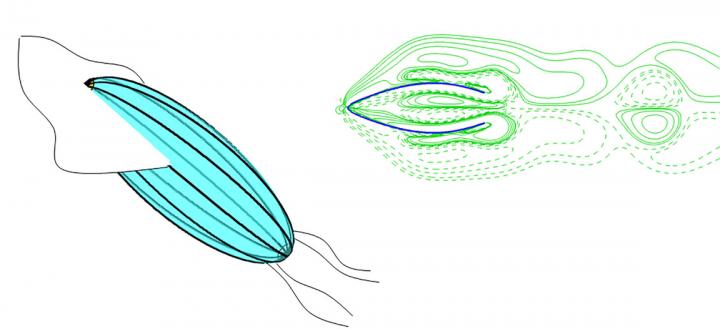Squid-inspired robots might have environmental, propulsion applications

Xiaobo Bi and Qiang Zhu discuss their work developing an aquatic robot inspired by cephalopods. (Left) Envisioned squid-inspired robot that combines fin flapping and jetting for locomotion. (Right) Numerical simulations provide insights of the underlying physical mechanisms. Credit: Qiang Zhu Usage Restrictions: Journalists may use this image only with appropriate credit.
Inspired by the unique and efficient swimming strategy of cephalopods, scientists developed an aquatic robot that mimics their form of propulsion.
These high-speed, squidlike robots are made of smart materials, which make them hard to detect — an advantage that has potential military reconnaissance and scientific applications — while maintaining a low environmental footprint.
Physicists Xiaobo Bi and Qiang Zhu used numerical simulations to illustrate the physical mechanisms and fluid mechanics of a squid's swimming method, which uses intermittent bursts through pulsed jet propulsion. By using this form of locomotion, the new device can achieve impressive speeds, just like its animal inspiration. Bi and Zhu discuss their work in this week's Physics of Fluids, from AIP Publishing.
When swimming, these squidlike machines suck water into a pressure chamber and then eject it. The soft-bodied device could be used as a platform for environmental monitoring by simultaneously using this feature to test water samples as it swims.
“In addition to the 2D and 3D numerical simulations presented in this article, we are working with an interdisciplinary team to build a prototype of the mechanical device, to perform both straight-line swimming and maneuvers,” Zhu said. “This project will combine fluid dynamics, control, smart materials and robotic design.”
The device could be used as either a stand-alone swimmer or as a propeller of an underwater vehicle.
The researchers have not yet been able to maintain speeds that can last for more than a few cycles due to turbulence and instabilities, but they are working on ways to overcome this. Zhu hopes this research will provide a starting point for more sophisticated modeling and experimental studies to develop robots like their creation.
###
The article, “Fluid-structure investigation of a squid-inspired swimmer,” is authored by Xiaobo Bi and Qiang Zhu. The article will appear in Physics of Fluids on Oct. 1, 2019 (DOI: 10.1063/1.5119243). After that date, it can be accessed at https:/
ABOUT THE JOURNAL
Physics of Fluids is devoted to the publication of original theoretical, computational, and experimental contributions to the dynamics of gases, liquids, and complex or multiphase fluids. See https:/
Media Contact
More Information:
http://dx.doi.org/10.1063/1.5119243All latest news from the category: Information Technology
Here you can find a summary of innovations in the fields of information and data processing and up-to-date developments on IT equipment and hardware.
This area covers topics such as IT services, IT architectures, IT management and telecommunications.
Newest articles

Properties of new materials for microchips
… can now be measured well. Reseachers of Delft University of Technology demonstrated measuring performance properties of ultrathin silicon membranes. Making ever smaller and more powerful chips requires new ultrathin…

Floating solar’s potential
… to support sustainable development by addressing climate, water, and energy goals holistically. A new study published this week in Nature Energy raises the potential for floating solar photovoltaics (FPV)…

Skyrmions move at record speeds
… a step towards the computing of the future. An international research team led by scientists from the CNRS1 has discovered that the magnetic nanobubbles2 known as skyrmions can be…





















